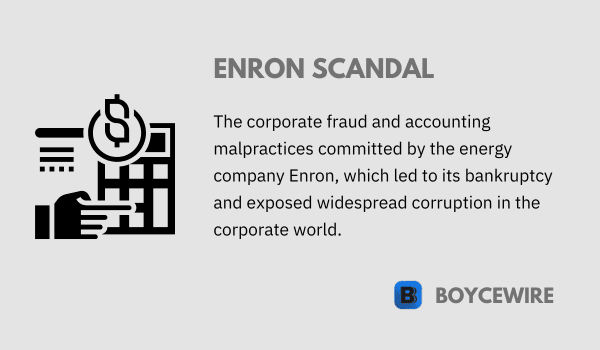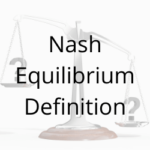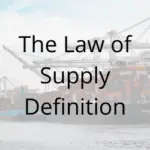Enron Scandal: Definition, Causes, Effects, & Examples

What is the Enron Scandal?
In the annals of corporate history, few events have resonated as profoundly as the Enron scandal. A tale of greed, deception, and catastrophic failure, it left an indelible mark on the corporate landscape and provoked a reevaluation of business practices, regulatory oversight, and the role of corporate ethics.
Enron, once hailed as a beacon of innovation and a darling of Wall Street, collapsed under a labyrinth of deceit that hid its true financial state. Its implosion led to billions in lost wealth, thousands of lost jobs, and the downfall of Arthur Andersen, one of the world’s largest accounting firms.
Key Points
- The Enron scandal was one of the biggest corporate scandals in history, involving the energy company Enron Corporation.
- Enron executives used accounting loopholes and special purpose entities to hide debt and inflate profits, leading to a false image of financial success.
- The scandal was exposed in late 2001, when Enron filed for bankruptcy, revealing massive financial losses and the manipulation of financial statements.
Background of the Enron Scandal
Enron Corporation was an American energy company based in Houston, Texas. It was formed in 1985 by Kenneth Lay following the merger of Houston Natural Gas and InterNorth. Initially, the company was involved in the distribution of gas, but it later expanded its business and became a major player in the energy trading and commodities markets.
Under the leadership of CEO Jeffrey Skilling, Enron adopted an aggressive approach to business. Employees were incentivized with high bonuses to secure energy contracts, fostering a competitive and ruthless environment. This drive for revenue growth led to the implementation of questionable accounting practices and financial reporting methods.
Enron employed mark-to-market accounting, which allowed the company to record potential future profits on the day a deal was signed, even if those profits were speculative or uncertain. This optimistic approach to accounting contributed to an overstatement of Enron’s financial health and misled investors and stakeholders.
In addition, Enron utilized Special Purpose Entities (SPEs) to keep a significant amount of debt off its balance sheet. These entities were used to hide debt and inflate reported profits, giving the illusion of financial stability and attractiveness to investors. Enron’s investment-grade credit ratings further masked its true financial condition and allowed it to continue obtaining financing and engaging in risky business ventures.
During the late 1990s, Enron’s stock price soared, and the company was praised as one of the most innovative in America. However, behind the scenes, Enron’s fraudulent practices and unsustainable financial situation were brewing, leading to its eventual downfall.
Summary of the Scandal
The Enron scandal, which came to light in October 2001, resulted in the bankruptcy of Enron Corporation and the collapse of Arthur Andersen, one of the world’s largest accounting firms.
The scandal was fueled by the revelation of substantial hidden debts and liabilities that had been kept off Enron’s financial statements. The company used a complex network of off-the-books partnerships and entities to conceal debt, inflate profits, and mislead investors and stakeholders about its true financial condition.
Enron’s executives, aware of the company’s precarious situation, engaged in insider trading by selling off their own shares while encouraging employees and shareholders to buy more. They publicly reassured investors that Enron was financially stable, while behind the scenes, the company was facing significant financial risks.
The scandal began to unravel when Wall Street Journal reporter John Emshwiller raised concerns about Enron’s financial transactions and partnerships through a series of articles. Additionally, Sherron Watkins, a vice president at Enron, sent an anonymous letter to CEO Kenneth Lay, warning him about the company’s accounting practices.
In October 2001, Enron reported a substantial loss for the third quarter, along with a significant reduction in shareholder equity. These revelations triggered an investigation by the U.S. Securities and Exchange Commission (SEC), leading to Enron’s filing for Chapter 11 bankruptcy in December 2001.
The aftermath of the scandal resulted in significant regulatory changes aimed at improving financial reporting and corporate governance. The Sarbanes-Oxley Act of 2002 was enacted to enhance transparency, accountability, and the accuracy of financial disclosures for publicly traded companies. The Enron scandal serves as a prominent example of corporate fraud and its far-reaching consequences in the business world.
Causes of the Enron Scandal
The Enron scandal was a result of various factors that contributed to the company’s downfall. These causes can be attributed to corporate governance issues, conflicts of interest, fraudulent practices, misleading financial reporting, regulatory oversight shortcomings, and a culture of greed and unethical behavior. The following are key factors that played a role in the Enron scandal:
- Poor Corporate Governance Enron’s Board of Directors failed to effectively oversee the actions of senior management, allowing executives to engage in risky financial practices without sufficient accountability.
- Conflicts of Interest Among Auditors Arthur Andersen, Enron’s auditing firm, provided both auditing and consulting services to the company. This created a conflict of interest, as Andersen had financial incentives to turn a blind eye to Enron’s fraudulent practices to protect their consulting contracts.
- Financial Engineering and Accounting Fraud Enron employed complex financial structures and accounting loopholes to manipulate its financial statements. The use of special purpose entities (SPEs) allowed Enron to keep debt off its balance sheet and artificially inflate its earnings.
- Misleading Financial Reporting Enron’s financial statements were intentionally misleading, lacking transparency and accuracy. The company manipulated its financial data and used aggressive accounting practices to present a false picture of profitability and financial health.
- Lack of Regulatory Oversight Regulatory bodies, such as the Securities and Exchange Commission (SEC), failed to adequately detect and address the financial irregularities at Enron. This highlighted shortcomings in regulatory oversight and the need for stronger enforcement and monitoring.
- Culture of Greed and Unethical Behavior Enron fostered a culture that prioritized personal gain and short-term financial success over ethical behavior. Executives were incentivized with bonuses and stock options tied to short-term earnings targets, promoting a culture of manipulation and deceit.
The convergence of these factors led to the massive fraud and eventual collapse of Enron. The scandal exposed systemic issues within the company and highlighted the need for improved corporate governance, ethical standards, and regulatory reforms to prevent similar incidents in the future.
Effects of the Enron Scandal
The Enron scandal had profound effects on various stakeholders and the business landscape as a whole. The repercussions of the scandal were far-reaching and led to significant changes in regulatory standards, corporate governance practices, and public perception. The following are key effects of the Enron scandal:
- Shareholder Losses Enron’s collapse resulted in massive financial losses for shareholders, including employees who had invested their retirement savings in company stock through the 401(k) plan.
- Job Losses Thousands of employees lost their jobs as Enron went bankrupt. This had a significant impact on the workforce and the communities where Enron operated.
- Bankruptcy of Arthur Andersen Enron’s auditing firm, Arthur Andersen, faced legal consequences for its role in the scandal. The firm was found guilty of obstructing justice, leading to the surrender of its licenses and eventual bankruptcy.
- Changes in Regulatory Laws and Practices The Enron scandal prompted significant regulatory reforms, culminating in the passage of the Sarbanes-Oxley Act of 2002. This act introduced stricter reporting requirements and imposed severe penalties for corporate fraud.
- Erosion of Trust The scandal eroded public trust in the corporate world. It highlighted the potential for large-scale fraud and manipulation within seemingly successful companies, leading to increased skepticism from investors, the public, and regulatory authorities.
- Litigation and Legal Consequences Executives involved in the Enron scandal, including CEO Jeffrey Skilling and Chairman Kenneth Lay, faced prosecution and received prison sentences. The scandal also triggered numerous civil suits against the company, its executives, and affiliated entities.
The Enron scandal served as a wake-up call, highlighting the importance of ethical leadership, financial transparency, and robust regulatory oversight. It spurred changes in corporate governance practices and brought about a heightened focus on accountability and integrity in the business world.
Lessons Learned from the Enron Scandal
The Enron scandal had a profound impact on corporate governance, accounting practices, and regulatory policies. The following are key lessons learned from the scandal:
- Importance of Transparency The Enron scandal highlighted the critical need for transparency in business operations and financial reporting. Companies must provide accurate and comprehensive information to stakeholders to ensure trust and avoid misleading practices.
- Robust Internal Controls The scandal emphasized the importance of implementing robust internal controls and audit procedures. Companies should have checks and balances in place to detect and prevent fraudulent activities.
- Ethical Corporate Culture Enron’s downfall demonstrated the damaging consequences of a culture that rewards unethical behavior. Organizations must foster a culture of ethics, integrity, and accountability from top to bottom.
- Role of Boards and Auditors The scandal raised questions about the role of boards of directors and auditors in ensuring financial probity. Independent and vigilant board members and auditors are essential for effective oversight and preventing corporate misconduct.
- Employee Protections The Enron employees who suffered job losses and financial losses highlighted the need to protect employees from the consequences of corporate misconduct. Reforms have focused on diversifying employee retirement investments and improving safeguards for employee interests.
- Regulatory Reforms The scandal prompted regulatory reforms, including the enactment of the Sarbanes-Oxley Act. Ongoing regulatory updates and enforcement are essential to prevent financial misconduct and adapt to evolving business practices.
The Enron scandal serves as a sobering reminder of the devastating impact of corporate greed, lax oversight, and flawed governance. The lessons learned from Enron continue to shape contemporary business practices, emphasizing the importance of transparency, ethical behavior, and effective regulatory measures.
FAQs
The Enron scandal was a corporate scandal involving the energy company Enron Corporation, where executives engaged in accounting fraud and deceptive practices to conceal financial losses and inflate reported profits.
The Enron scandal unfolded in the early 2000s, with the company’s fraudulent activities coming to light in late 2001.
The main reasons behind the Enron scandal were unethical practices by top executives, including the use of special purpose entities to hide debt, manipulation of financial statements, and inadequate corporate governance.
The consequences of the Enron scandal were significant, including the bankruptcy of Enron, the dissolution of the accounting firm Arthur Andersen, financial losses for shareholders and employees, and a loss of trust in corporate governance and accounting practices.
About Paul
Paul Boyce is an economics editor with over 10 years experience in the industry. Currently working as a consultant within the financial services sector, Paul is the CEO and chief editor of BoyceWire. He has written publications for FEE, the Mises Institute, and many others.

Further Reading
 Inferior Goods - Inferior goods are products or services that experience a decrease in demand as consumer income rises, typically due to the…
Inferior Goods - Inferior goods are products or services that experience a decrease in demand as consumer income rises, typically due to the…  Nash Equilibrium: Definition, Limitations & Example - Nash equilibrium refers to the situation whereby a group of individuals choose the most optimal strategy and do not deviate…
Nash Equilibrium: Definition, Limitations & Example - Nash equilibrium refers to the situation whereby a group of individuals choose the most optimal strategy and do not deviate…  Law of Supply: Definition & Example - The law of supply is the relationship supply has with price. As prices rise, businesses supply more. As prices fall,…
Law of Supply: Definition & Example - The law of supply is the relationship supply has with price. As prices rise, businesses supply more. As prices fall,… 